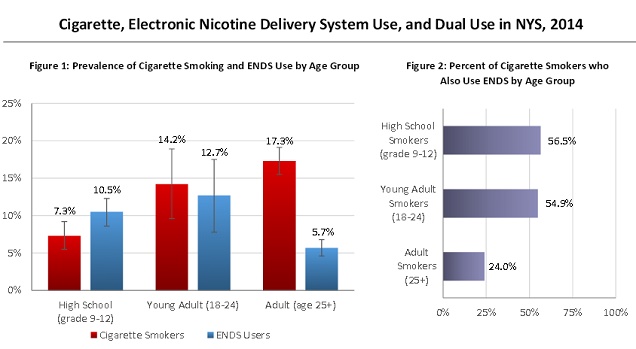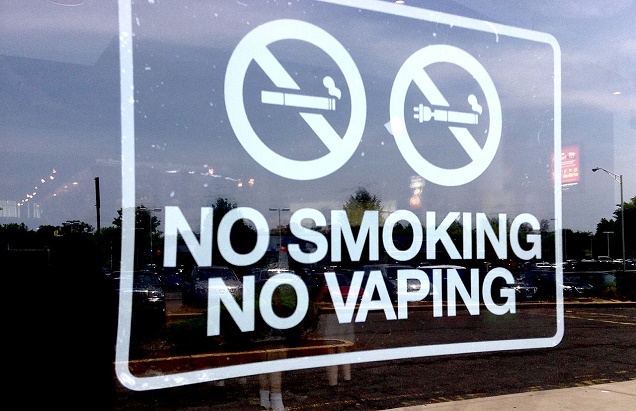
It’s been a busy week for e-cigarettes. But with evidence-free attacks on the evidence-based conclusion that vaping is likely to be around 95 % safer than smoking, bans on indoor vaping, absurdly high taxes proposed on e-liquid and Malaysia taking distinct turns towards anti-vaping extremism of the worst variety (raiding e-cig stores to look for nicotine juices and reaching new lows when it comes to media bullshit), it’s also been a decidedly grim Week in Vaping. So – if you can stomach it – let’s dive in.
E-Cigarette Research
A new study looks at the patterns of e-cigarette use among adults, using data from the 2014 National Health Interview Survey, finding that current vaping is extremely low among never smokers (0.4 %) and long-term former smokers (0.8 %), and that daily vaping is highest among recent quitters (13 %), who are likely to have quit by vaping. This contradicts many of the common criticisms about the potential unintended consequences of the rise in vaping, and Michael Siegel writes that the study shows that vaping is an overall benefit to public health.
A report from New York has found that more high school students vape than smoke, with 10.5 % of 9th to 12th graders vaping (at least one day in the past 30), compared to 7.3 % smoking. Over half of high school or young adult (18 to 24) smokers also vape, which the report claims shows that there’s “no evidence” that young people are substituting vaping for smoking. Maybe if they’d asked about the number of cigarettes smoked they could have avoided reaching such a ridiculous conclusion.

After Public Health England estimated that e-cigarettes were around 95% safer than smoking, there was a huge backlash from those who have been making out that e-cigarettes were actually dangerous, and this backlash has continued with the release of a new “info”-graphic from the British Medical Journal.
“Info” deserves quotation marks because there is precious little information actually there; instead, it’s a pathetically cherry-picked “web” of influence that supposedly tracks the report back to commercial interests (including tobacco and e-cig companies). Basically, it’s an infographic that sticks its fingers in its ears, throws evidence out of the window and cries “conflict of interest!” as if it’s a substitute for data.

This has received an excellent piece of criticism from Clive Bates that is well-worth reading in its entirety. Dr. Konstantinos Farsalinos has also blogged about it, saying it “should be completely ignored,” the New Nicotine Alliance asks if the BMJ is a danger to public health and Christopher Snowdon has posted about how the magazine is now filled with “crackpots and conspiracy theorists.”
The real story here isn’t about evidence, it’s about groups doing everything they can (apart from debate the science) to discredit it. Clive Bates’ discussion of how those opposed to e-cigs responded to the 95 % safer claim really sums the whole saga up quite well:
They hated it, and moved to red-alert status. Why? I can only speculate, but I think they believe in their own authority: that everyone should do as they are told, and quit smoking completely or face a miserable life and lingering death – quit or die, submit or succumb. E-cigarettes offer a third alternative that empowers the user, and they really don’t like that. So the response has been to throw up a blizzard of distracting hype and spin to conceal the awkward truth that technology might be starting to deal with smoking without their involvement and without relying on their traditional toolkit of punitive and controlling measures.
Legislation, Regulations and Vaping Bans

Connecticut has passed a new law banning vaping in indoor locations, including state buildings, health care institutions, food stores, bars and restaurants, schools, child-care facilities, elevators, public or private college dorms, dog race tracks or other places where you can gamble on racing or sports. The maximum fine for vaping is $90.
The city of Hutchinson, Kansas has voted to ban vaping where smoking isn’t allowed, making a limited number of exemptions for e-cigarette stores, casinos, private clubs, up to a fifth of hotel rooms and smoking areas of long-term care facilities. The rule was largely pushed to ensure “consistency” with smoke-free laws, as if vaping and smoking should be treated as equivalent.
New Mexico is considering taxing e-liquids, at a rate of 4 cents per mg of nicotine (which would work out to $7.20 for a 15 ml bottle of 12 mg/ml juice – near doubling the price for many e-liquids). This exact same proposal didn’t make it past the first committee this year, but it looks to be on the cards again for next year.
The Vaping Giraffe offers some more insight into what’s going on in Norway with the potential plans to implement the EU tobacco products directive. The blog post points out that it appears that politicians in Norway have been misled about the likely consequences of the regulations, and that while Norway could go against the European ruling, the consequences of making that decision are uncertain.
Despite assurances that vaping would not be banned in Malaysia, 300 stores were raided this week “to check on the nicotine content of some of the liquids.” If e-liquids contain nicotine, they are subject to the Poisons Act, which states that nicotine can be only be supplied or sold as a medicine or an ingredient in a medicine by a registered medical practitioner. Cigarettes, of course, still remain freely sold and stores selling them are not subject to raids, a point which has been raised by vape store owners in Malaysia.
The Smoke-Free Alternatives Trade Association has released guidance to its members about requesting and attending meetings with the Office of Management and Budget, who are currently reviewing the FDA’s e-cig regulations. Generally, the intention of the guidance is for companies to stress the financial burden that the regulations will have on companies.
Other Vaping-Related News and Blog Posts

A Malaysian vaping conference went ahead successfully despite much discussion of a potential vaping ban in the country, encouraging good etiquette and raising awareness of issues related to vaping culture as well as serving as a place for Malaysian vapers to pick up new gear. It was humorously called “Vapegasm 1.0.”
Although not directly related to vaping, Michael Siegel wrote a blog post this week taking aim at the common claim that reducing the amount you smoke offers no health benefits. In the post, he points out that while the reduction in heart disease risk is limited (he says non-existent, but Carl V. Phillips comments and corrects this), the reduction in risk of lung-related issues is substantial, and (although he doesn’t mention this) lung cancer risk decreases too. Contrary to what many of those opposed to vaping claim, cutting down is a good thing.
Carl V. Phillips has published a couple of blog posts about regulations for e-cigarettes, addressing how what’s already happened to smokeless tobacco is likely to repeat itself for e-cigarettes, and about how the currently proposed regulations are not really regulations in the way most people would understand it.
The BBC has published a short article entitled “should we switch from tobacco to e-cigarettes?” with some interactive graphics and discussion, generally following the guidance laid down by Public Health England’s report. The answer, obviously, is yes you should.
Louise Ross – who made her city’s stop smoking service e-cig friendly – has written a great post that’s featured on Clive Bates’ blog about how scaremongering about e-cigarettes isn’t in the best interests of smokers.
An article from ChurnMag lists 11 studies the FDA should read before regulating e-cigarettes (although I’m sure they have read them, the point is well made).
The Ashtray Blog has published a post about leaking clearomizers and what you can do to stop the issue. They’ve also done a sleek rebranding of their juices, which we’ll have a brief review on soon!
Bullshit of the Week – “Nicotine is More Addictive Than Cigarettes”

Malaysia isn’t exactly tackling the whole vaping issue very rationally, and there is no better proof of that than this recent article in the Borneo Post, which includes this quote from state health director Dr. Zulkifli Jantan: “Nicotine is more addictive than cigarettes because it is inhaled directly into the lungs during vaping.”
How those words could find their way out of the mouth of someone with “Dr.” in their title and with the position of health director thoroughly boggles the mind. Apparently, at no point between first formulating that immensely ridiculous statement and deciding to repeat it to a newspaper did he think “hmm… wait a minute, cigarettes contain nicotine and they’re inhaled into the lungs in exactly the same way, so maybe I’m talking absolute bullshit.”
This couldn’t be further from the truth, since all available evidence is pretty unanimous on this issue: e-cigarettes (and nicotine) are less addictive than smoking. Even without this knowledge, there is obviously nothing whatsoever to suggest that inhaling nicotine through e-cigarettes would be more addictive than inhaling it through cigarettes. At worst it would be exactly the same.
Apparently not content with parading his ignorance (willful or not) on the addictiveness issue, Jantan actually said e-cigarettes are more harmful than cigarettes.
Needless to say, if there was actually any data to support that assertion (rather than the exact opposite), public health and anti-tobacco groups would have been screaming about it from the rooftops from the day it was released.
Additionally, had we noticed this article from Malaysia last week, it would have taken the title of bullshit of the week by a long stretch, for the statement: “studies [have] shown that one hour of vaping was equivalent to smoking 150 cigarettes.” For “studies have shown” read “we want you to believe in the total absence of evidence.”
Conclusion – Is it Getting Worse, or Is it Just Me?
Sometimes putting together the Week in Vaping is immensely depressing. While research continually shows that e-cigarettes are much safer than smoking and appear effective for helping smokers quit, verbal excrement continues to spew throughout the media and legislators take overly harsh steps to stamp out vaping in any way possible. The disconnect between the reality of vaping and how it’s treated is stark, and deeply troubling.
Check back next week for more! Hopefully there’ll be some better news then.

